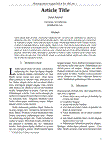| Summary: | Shrimp culture in inland low-salinity well water is a growing industry in many regions ofthe world, including the southern United States of America. Although shrimp culturetechniques in waters of marine origin are well established, they are not necessarilyapplicable to shrimp culture in low salinity well water. Inland well waters tend to varyamong each other in salinity and ion profiles. If shrimp culture using inland well water isto develop further, we must systematically deal with production problems which include 1)identification of suitable water sources 2) development of acclimation and stockingprocedures 3) identify specific nutritional requirements for low salinity environments. Thispaper summarizes work that we have done to a) assist in the development of acclimationprocedures for Litopenaeus vannamei postlarvae (PL), b) evaluate a variety of well watersources for their culture potential and identify mineral imbalances that may be correlated topoor survival and growth c) provide baseline data for the identification of nutritionalmanipulations that may mitigate the variable survival that has plagued low salinityproduction systems. Results suggest that PL survival in native seawater is affected by aninteraction between PL age and water salinity. In native seawater, ten day old PL exhibitedgreater survival at salinities greater than 4 ppt than at salinities of 2 ppt and lower. Fifteenand twenty-day old PL survived in salinities as low as 1 ppt. Survival of PL in well watervaried among water sources, and was affected by the concentration of various ions such aspotassium (K+), magnesium (Mg2+), and sulphate (SO42-), as well as PL age. Based oncurrent data, the supplementation of potassium to well water sources “low” in potassiumwill result in increased growth and survival. Based on our limited knowledge of theinteraction of salinity and nutritional requirements the supplementation of potassium,magnesium and sodium chloride as well as selected amino acids and potentially lipidscould mediate some of the problems encountered when rearing marine shrimp in lowsalinity production situations. Current data suggests that nutritional and/or environmentalmanipulations are technically feasible and probably are the most economically viablesolutions to facilitate better production in many of the low salinity farms.
|
|---|
